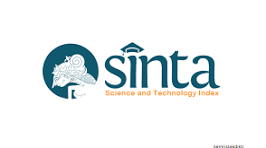Uji Optimalitas Menggunakan Metode Stepping Stone untuk Solusi Layak Awal dengan Metode Direct Sum dan New Heuristic Method
Abstract
This research discusses solving the transportation problem of minimization cases using the Direct Sum Method and New Heuristic Method on balanced and unbalanced data to determine an initial feasible solution, which is then tested for its optimality using the Stepping Stone Method. The stages of the Direct Sum Method, then, the largest direct amount cost is selected. Next, the lowest cell and allocate the minimum demand or supply are selected, then the lowest cell is selected again until all demand and supply are met. While the New Heuristic Method stages followed by selecting the lowest cell, and the minimum demand or supply is allocated, then the lowest cell is re-selected until all demand and supply are met. Based on the analysis with the Stepping Stone Method, the Direct Sum Method has more optimal results and has a slight change in allocation compared to the New Heuristic Method.
Keywords: Direct Sum Method, Linear Programming, New Heuristic Method, Operations Research, Stepping Stone Method, Transportation Problem.
Abstrak
Penelitian ini membahas tentang penyelesaian masalah transportasi kasus minimasi dengan metode Direct Sum dan New Heuristic Method pada data seimbang dan tidak seimbang untuk menentukan solusi layak awal, yang kemudian diuji optimalitasnya dengan metode Stepping Stone. Untuk tahapan penyelesaian menggunakan metode Direct Sum, kemudian dipilih biaya jumlah langsung terbesar. Selanjutnya, dipilih sel terendah dan dialokasikan permintaan atau persediaan seminimum mungkin, kemudian pilih kembali sel terendah sampai permintaan dan persediaan terpenuhi semua. Sedangkan tahapan penyelesaian menggunakan New Heuristic Method. Selanjutnya dipilih sel terendah dan dialokasikan permintaan atau persediaan seminimum mungkin, kemudian dipilih kembali sel terendah sampai permintaan dan persediaan terpenuhi semua. Berdasarkan analisis yang telah dilakukan pengujian optimalitas dengan metode Stepping Stone, metode Direct Sum memiliki hasil yang lebih optimal dan memiliki perubahan alokasi yang sedikit dibandingkan New Heuristic Method.
Keywords
References
Aguiar, G. F., Aguiar, B. C. X. C., Wilhelm, V. E. (2015). The MOMC method: A new methodology to find initial solution for transportation problems, Applied Mathematical Sciences, 9(19), 901–914.
Alkubaisi, M. M. (2015). Modified Vogel method to find Initial Basic Feasible Solution (IBFS) introducing a new methodology to find best IBFS, Business Management Research, 4(2), 22–36.
Dyson, R. G. (2000). Strategy, performance and operational research. Journal of the Operational Research Society, 51(1), 5-11.
Eisemann, K. (1964). The generalized stepping stone method for the machine loading model. Management Science, 11(1), 154-176.
Ford Jr, L. R., & Fulkerson, D. R. (1956). Solving the transportation problem. Management Science, 3(1), 24-32.
Hermansyah, H., & Ramadhani, E. W. (2016). Perbandingan metode stepping stone dan modified distribution dengan solusi awal metode least cost untuk meminimumkan biaya distribusi (Studi kasus produsen Mulya Telur Pontianak). Bimaster: Buletin Ilmiah Matematika, Statistika dan Terapannya, 5(3), 249-256.
Reza, A. K. M. S., Jamali, A. R. M. J. U., & Biswas, B. (2019). A modified algorithm for solving unbalanced transportation problems. Journal of Engineering Science, 10(1), 93-101.
Quddoos, A., Javaid, S., & Khalid, M. M. (2016). A revised version of ASM-method for solving transportation problem. International Journal Agriculture, Statistics, Science, 12(1), 267-272.
Singh, A. (2012). An overview of the optimization modelling applications. Journal of Hydrology, 466, 167-182.
Soomro, A. S., Junaid, M., & Tularam, G. A. (2015). Modified Vogel’s approximation method for solving transportation problems. Mathematical Theory and Modeling, 5(4), 32-42.
DOI: https://doi.org/10.17509/jem.v10i1.45492
Refbacks
- There are currently no refbacks.
Copyright (c) 2022 Mathematics Program Study, Universitas Pendidikan Indonesia

This work is licensed under a Creative Commons Attribution-ShareAlike 4.0 International License.

 Jurnal EurekaMatika
Jurnal EurekaMatika

